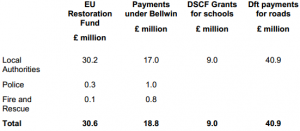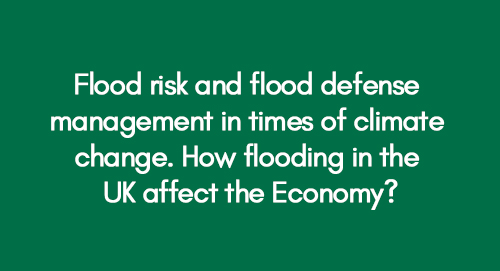
Capital Asset Pricing Model
February 27, 2021
Development of Sustainable Homes Through Renewable Energy Sources
February 27, 2021Introduction
The change in climate and average temperatures has affected various regions in the UK in recent years. The Greater London has experienced the impacts of climate change and the associated floods more than any other part of the country. The 2007 flooding had a considerable impact on the UK economy and therefore there is a need to design efficient flood risk management systems to minimise damages to the property, public as well as economy. This section of the paper discusses how flooding risk calls for improved flood defense management in times of climate change in the UK, particularly in London and what management choices are available to the government to minimise the threat of financial losses (Environment Agency, 2009).
Defra and other operating authorities including the Environmental Agency and Internal Drainage Agency have faced significant threat and challenge from the impacts of coastal erosion and flooding. Documented evidence shows that there has been a definite rise in seal levels in recent years, which has resulted in frequent flooding, rainfalls, and coastal storms, causing damage to the water and drainage systems in the United Kingdom. Exceptional rainfalls in the summer of 2007 cause great chaos among the population of the UK, particularly in areas such as Oxfordshire, East York shire and South York Shire, Gloucestershire, Worcestershire and Greater London. Extreme storms hit the shores following a prolonged wet season, resulting in a disastrous flooding from surcharging and overloading, heavy surface flows and subsurface drainage systems. The flooding also caused substantial damage to the properties, infrastructure as well as valuable flood defence systems. Thousands of evacuations took place and thousands were displaced across the country, turning the 2007 floods into a catastrophic situation. According to several claims, the floods resulted in a 4 billion pounds loss to the economy (The costs of the summer 2007 floods in England 2010).
Following the destruction caused by the 2007 flooding, there was a need to come up with a better strategy to manage the social as well as financial aspects of floods in the Greater London. Defra as well as other authorities in the UK decided to collaborate with key stakeholders to conclude on the current research and knowledge to be able to fully understand the impacts of frequent flooding on urban regeneration schemes, urban societies and cities. The key stake holders also took into account rural communities, societies and regeneration schemes for the purpose of understanding the impacts of flood. The authorities finally proposed recommendations for efficiently and effectively managing flood risk in both urban and rural areas of the country, using the advanced Catchment Flood Management Planning Scheme.
Another key objective was to understand the policy context for addressing damages caused by excessive flooding for both rural and urban societies and properties after understanding the impacts of flooding in details. Defra and other water and environment regulatory bodies also made an effort into defining a clear relationship between efficiency and effectiveness and stake holder management with respect to efficient decision making and flood risk management. A similar relationship was identified between the efficiency and effectiveness of flood response and flood risk management decision making and engagement of citizens and communities. The importance of social sciences with respect to flood risk management was also reviewed. Finally, the Environment Agency of the UK performed various research studies in an effort to determine the costs of the summer 2007 floods in England, highlighting vulnerable locations, properties and communities whilst estimating the financial, insured and non insured, economic losses similar flooding incidents may cause in the future (Morris et al, 2008).
Research Questions
- Does climate change results in excessive flooding in the UK?
- How the Climate Change is affecting various parts of the UK?
- Who is managing flood risk in the UK?
- What defense management options and policies are available to the government in times of clime change?
- What are the potential impacts the flooding can have on country’s economy?
- How can the impacts on economy be minimised?
Research aims and objectives
- To analyze the impacts of recent floods on economy, population and businesses
- To review the literature on the likely climate change scenarios
- To ensure the policy response are reasonable and appropriate to the needs of London and the UK
- To develop a better understanding of the extent and kind of effect flooding can have
- To provide draw reasonable conclusions for those who may need to take action
- To identify areas of further information and collection and research
Literature Review
This section will review the literature available on the topic of research. As discussed before in the introduction section, the UK, particularly, the Greater London has experienced considerable financial and social losses in the times of climate change. The UK government therefore needs to design effective risk management system to minimise the damages to population and economy. Climate change and flooding can have significant impacts on various industries including Transport, Energy, Insurance, Manufacturing, Financial Services, Tourism and Leisure, Creative Industries, Public Administration and environmental businesses and therefore the best risk management practice should be determined. The 2007 flooding resulted in a catrsophic situation as thousands of houses were evacuated and majority of the population in the affected areas were displaced. Moreover, there was a substantial loss caused to the properties in urban areas including the London City and to the landscapes in the rural areas of England.
Methodology Statement
A multi-method research approach along with the presentation of secondary data was completed in this research. Application of inductive type approach was utilized to structure the layout of the methodology used; with respect to various flood risk management, especially for urban and rural flood risk management. Approach recommended by various previous research articles / published paper was used to develop an understanding of the activities and policies being implement to safe guard the land and other resources from the flood hazard
The data has been collected from the research completed by various accounting bodies / researchers to estimate the financial and social loss caused by the 2007 flooding and the possible policy narratives that can be associated to the flood risk management in rural and urban areas to minimise the impacts of flooding the future.
It is vital to differential between the urban and rural areas of the UK to be able to form a clear flood risk management systems. The importance of landscapes in the rural context and the issue of design in the urban context cannot be ignored (Efra, 2008). It should be noted that the “rural” and “urban” terms are used frequently in the literature relevant to the flood risk management but Defra and other water drainage agencies in the UK do not have explicit definition of what constitutes rural and urban. Perhaps, the type of preventive measure and the type of flooding can define these terms in the best possible way. This review of literature and the methodology adopted is an effort of studying the rural and urban policies to be able to understand how modern flood management systems are associated to rural landscapes and urban designs (Pitt, 2008).
Urban (London) Flood Risk Management
There have been various attempts by organizations, especially the Environmental Agency with regard to flood risk management in London. One such example is the flood risk management strategy within the Thames Estuary. It is stated by the agency that the Thames is said to have the best protection standard in the form of tidal defence which would be sufficient until and beyond the year two thousand and thirty. In response to the concern stated, the Environment Agency developed a hundred year protection plan which covers the area from Teddington beginning in the western part of London to Shoeburyness which extends to the eastern part of the Estuary. Amongst other things, this Project was aimed at understanding the tidal defence strategy in a wider context which included but not limited to climatic change, environment, social pressures and urban development. Furthermore it also aimed at gaining financial and moral support of all the stakeholders including politicians (BenneG, 2010), which would be inherently followed by a management scheme covering the tidal defence protection strategy for up to a hundred years. Amongst the various concerns in protection of Thames, it was also noted that efficient protection would include conservation of the heritage of London as well including the environment and its subsequent biodiversity. Therefore as a part of the whole Project, the Agency identified various habitats which aimed and continued to promote while sustaining biodiversity and subsequently restored parts of the flood plain to sustain the said habitats.
Furthermore Thames Gateway London Partnership states and reinstates that compulsory purchase orders could be employed not only for site acquisition but also for management of flood risk and environmental improvement. Another useful tactic employed through the Thames Gateway London Partnership was the involvement of public.
As stated earlier, various agencies and organizations have been involved in research and implementation of flood risk management schemes and strategies. The urban part of the management has gained sufficient importance and it can be deciphered from the ODPM, 2000, that both the social and physical environment must be interrelated for them to create a support community. Urban development policy and flood risk management have been enshrined into one another to ensure optimal utilization of resources, which includes a holistic and planned design for urban development, green spaces that are for public use and developing communities and development spaces.
It is said that urban spaces especially green have an important role to play in the flood risk management strategies. Physically, they provide an area which can absorb water but also enhance flood alleviation. Furthermore ODPM, 2000, places a great amount of emphasis on engagement of the community so that they can individually assume responsibility which not only includes individual citizens but also community groups, voluntary groups and the private sector organizations (OPDM, 2010).
Rural Flood Risk Management
Flood risk management has been linked with rural development as an inter related and a coherent concept. Defra, 2000, states that four aspects of a rural countryside, which include, the protected countryside, the living countryside, the working countryside and the vibrant countryside, all of which are deemed to be an important part of the rural flood risk management program. Flood risk management inherently is a part of the rural environment, as it has helped shape up the landscape. It is the inherent nature of the flood, be in frequent or infrequent that shapes the rural communities and their lifestyles.
Whenever focus is drawn to the rural communities’ development in reference to flood risk management, the main focus of the whole argument is the management of land in terms of flood alleviation. Defra, 2005, points out the various government schemes that have been put into place for the flood management and alleviation. First and foremost, the construction and implementation of wash lands and wetlands along with restoration of river beds, widening of the river corridors, and realignment of coastal areas are form the part of flood risk management within the rural developmental scheme (Defra / Environment Agency, 2005).
It is further thought by the government agencies and organizations dealing with flood risk management within the rural areas in United Kingdom that introducing these schemes and modifications to the landscape would inherently reduce the flooding incidences to a substantial amount. Furthermore, involvement of famers is seen to be extremely important and they have been taught to use their land to enhance and implement these said modifications.
The cost of summer 2007 Floods
It is estimated that over three point two billion pounds were spent in total costs relating to economic infrastructure, and over two third of these costs had been incurred through businesses and households which included temporary accommodation and vast damage to commuting vehicles (The costs of the summer 2007 floods in England 2010). Utilities and power account for about ten percent of the total loss, and the communication infrastructure amounts to about seven percent. A total of about four percent of the loss was incurred by authorities of the local government whereas less than one percent was covered by policemen, fire rescuers and emergency services. Public health impacts were about nine percent of the loss, and this comprised of educational and mental health services. Lastly, damages to agricultural sector accounted for about two percent of the flood costs. Furthermore, the total estimated costs for the two thousand and seven flood amounted to over four billion pounds which is roughly around ninety percent of the commercial and residential related cost.
The most severe damage was incurred by national infrastructure which was estimated to six hundred and seventy four million pounds, followed by a serious loss to the education sector which amounted to the students missing about four hundred days of schooling.
The estimated cost to the agricultural sector amounted to about 50 million pounds, which is estimation from detailed visits to the farms and personal interviews with farms that were flooded as a result of the same. Average cost per flooded hectare was one thousand one hundred and fifty pounds, and it was noted that these average costs were different from every region around the United Kingdom.
By far the largest amount of losses incurred was by the residential and household sector. According to Efra, 2008, forty six thousand properties were a victim of flood destruction, whereby Pitt, 2008, stated that about forty eight thousand homes fell prey to the destruction caused by the two thousand and seven floods. The agencies used insurance claims to determine the amount of damage caused economically, however these figures have various discrepancies since not all losses were insured therefore could not be claimed and it may be also accounted to that a lot of losses might not have been reported or claimed in the first place. Carpenter, 2007, estimated that these insured losses amounted up to forty thousand pounds, whereas a more recent research conducted by ABI, 2009, stated that the losses amounted to over one hundred and seventy two billion pounds, but these too account for the insured claims only.
With regard to business properties it is estimated by Efra, 2007 that about seventy one hundred properties were damages whereas, Pitt, 2008, states that seventy three hundred properties were damaged in the floods. According to Association of British Insurers (ABI, 2009), thirty five thousand insurance claims were filed. Various adjustments were made to decipher and estimate the amount of damage caused by the floods to commercial properties, and it was found that the economic costs ranged between zero point thirty one billion pounds to zero point fifty eight billion pounds, without an exact consensual figure amongst them.
Over and above the commercial properties cost for damage, insurance claims were also made for disrupted businesses which further resulted in various forms of loss to the business and company running thereby escalating the loss to a substantially higher figure.
Findings and Analysis
The economic impacts of flooding will mainly include the costs of clean up and damages done to property of population. It further takes into account the cots associated to finding and living in a temporary accommodation in flood affected areas. A house affected by flood is also likely to be sold for a cheaper price. The estimated damage costs of the residential as well as commercial properties have been estimated by the environmental agency as per the following;

Figure 1: Property damage estimation of 2007 flood (source: The costs of the summer 2007 floods in England, 2010)
Travelling and time costs are other factors, such as railway and road traffic, that contribute to the economic losses. According to an official estimate, the total costs (for travel) accumulated to 10.50 million pounds for infrastructure damages, excluding the losses of traveller’s time. Furthermore, the small communities in Greater London and other parts of the UK where there are few facilities, the loss of business platforms, property, shops and services can have a substantial impact on economy. According to an estimate, there were thousands of insurances claims made for the property losses as shown in the figure-1. In developed regions and cities like London, there is a risk of losing perception of the area being an attractive place for business if there is constant risk of floods.
It is imperative to note that not only economic loss, but the loss caused through distress and a disrupted business is extremely high. Commercial businesses suffered from great loss because their businesses were disrupted for over a period of couple of months. Similarly as stated above, students from various regions had to miss about four hundred days of school because of an innumerable loss to the educational sector including, but not limited to destruction of the school property.
There was also noted to be an impact on public health. According to HPA, 2010, over 2000 people reported to have heath concerns after the 2007 floods. High floods accumulated to high risk level and the breeding ground for many diseases. Not only physical health detriments but residents and individuals suffered through great psychiatric stress and trauma after the loss of their loved ones and monetary facets.
The costs suffered in terms monetary loss have to date yet to be covered by the government. However, the loss of lives and disruption in economy especially after the world economic crisis is too heavy for the United Kingdom to recover from. The government has been involved in various schemes and policy discussions, which will be discussed below. It should also be noted that although the financial loss was quite significant in terms of numbers, it did not have a long lasting impact on the economy of the UK.
According to the environment agency and defra, several grants were provided to the local english authorities and other emergency services in order to support the losses of 2007 floods, details of which are as shown in the figure table below;

Figure 2: Property Grants/supports provided to local authorities (source: The costs of the summer 2007 floods in England, 2010)
Summarising, the UK government and other Environmental, Health and Safety authorities in the UK are required to performed extensive research to identify areas or places vulnerable to flooding. The Greater London and various other parts of the UK have been hit hard by the rain in recent years due to the change in climate. An efficient and effective policy and planning needs to be done to tackle the challenges presented by the flooding, particularly in areas where there is a high risk to human lives and expensive properties. The financial as well as social aspects should be taken into account when making an effective policy and procedure to deal with similar situations in the future. The governmental agencies are working closely with various development teams to manage and enhance the protective activities/policies, which has been discussed in the section as below
Policy Discussion
The current state of affairs requires a greater emphasis on urban areas because of the high prices of the properties. Although these areas are less likely to be effected by the flooding, there is a need to secure defences to protect the global image of these places and avoid disastrous economic consequences. Currently, the Environment Agency is mainly focusing on rural areas where the loss to property and infrastructure can have a big impact on the population.
There is a dire need to identify and enhance the information present for flood management, for which the environment agency is keenly working upon. The Somerset levels experienced an increased flooding in the early 2014. Realizing the need for enhanced flood protection, the agency presented a flood action plan in 2014. According to the Somerset Levels and Moors: reducing the risk of flooding (2014), flood water of more than 65 million m3 covered the area and many of the residents had to leave their homes. The Somerset’s council’s plan considered various sustainable management and flood resilience options (such as maintenance, land-management and community and business resilience) and further progressed to dredge nearly 8 km of the River Parrett and Tone.
According the senior leadership of the government, an investment of £10.5 million has been approved on top of the previously announced £10 million (by the Prime Minister). An additional £1.5 million has already been raised towards ‘flood prevention measures/activities’ across the Somerset authorities/partners. The details on the policy is available at the Somerset county council news room
Although the Environmental Agency has been reported to reduce the flooding risks through attainment of the support provided by the government, there is a need to complete an extensive research with regards to climate change and risk assessment, with specific focus on geological areas. Furthermore, it is apparent that there are various institutions/policies responsible for flood management, however, the need to regularise the working of these institutions/policies is mandatory. For example if the policy implicates the need of dredging, it must consider the impact in terms of its pros and cons on the environment at large. The process is known to alter the river morphology, which may results in a change (positive or negative) in wild-life habitat, water currents, water quality, and suspended sediments. Therefore, determination of the impact of dredging is extremely important in terms of evaluation of environment, in both long and short term, with respect to effects as well as the sustainability of the altered environment. Furthermore, policy directions for research and development within the field of flood risk management and environment conservation is essential for optimum results.
Conclusion & Recommendations
The research was conducted to look at the social impacts of flooding on the UK, particularly in Greater London in terms of economy. The literature available on the matter was thoroughly researched and an effort was made to identify issues important to key stakeholders. The flooding in the UK has increased in recent times, thanks to the effects of climate change. The 2007 UK floods statistics were examined to determine the extent of losses that occurred. Based on the gathered information, the best risk management options are discussed with respect to the flooding in rural and urban areas. Stereotypes around the name of rural and urban regions do exist and such approach could prove to be very unhelpful and the Environment agency must work in partnerships with others to achieve long term objectives.
Furthermore there is a need for the primary Environmental agency to extend its responsibility for flood management to various subsidiary bodies, perhaps divided through geological or regional preferences so that management and risk assessment is efficient and reached its optimum level. Regional government must indulge in cooperation across different region so that not only aid can be provided to lesser developed regions but also to ensure that best practices from various regions regardless of their development status can be implemented. Lesson learnt from within the United Kingdom would be apparent to the agencies by now, which would inherently revolve around the mere notion of lack of preparation for the flood disaster. There should be in place a scheme for regional management as well relocation schemes and agencies that can provide moral and financial help from inside the country rather than being dependant on international aid so as to not put the economy in further loss and debt.
Most importantly, the government agencies must involve themselves in encouraging and implementing awareness strategies amongst the residents of United Kingdom, so that in case such a crisis occurs again, it can deal with efficiently. It was also noted that after residential and household losses, the highest amount of loss incurred was in the form of commercial loss in business. Business operators should be encourages through a scheme of incentives to have off shore operations in the face of such disasters with requisite support provided from the relevant governmental agencies and departments. Also, it would be a good initiative if the agencies were to create awareness amongst the business circle so that disaster management schemes are in place before such a disaster can hit the region.
References
- Association of British Insurers-ABI, (2009). ABIConsumer Guide: A guide to resistant and resilient repair after a flood
- ADAS, (2008). Impacts of 2007 Summer Floods on Agriculture. Report to Department for Environment, Food and Rural Affairs. ADAS, CambridgeDaniels J. D., Radebaugh L. H., and Sullivan D. P. (2011) International Business: Environments and Operations, 13th Ed., Pearson.
- ASFPM (The Associa0on of Floodplain Managers), (2013), Flood Mapping for the Nation – A Cost Analysis for Nations Flood Map Inventory
- BenneG, O. (2010), Reducing Flood Risk: Key Issues for the New Parliament 2010-House of Commons Library Research
- Carpenter, G., 2007. Wrong Type of Rain: Impact and Implications of 2007 UK Floods
- December 2007. Guy Carpenter, London.
- Cavusgil, S. T. et al (2011) International Business: Strategy, Management and the New Realities, 2nd Edition, Prentice-Hall.
- Conklin, D. W. (2011) The Global Environment of Business: New Paradigms for International Management, SAGE.
- Cullen, J. B. and Partoteeah. K. P. (2010) International Business, Strategy and the Multinational Company, Routledge, N.Y.USA
- Czinkota, M. et al (2009) International Business, Wiley, Chichester.
- Dicken, P. (2009) Global Shift, 4th Edition, Sage, London.
- Defra / Environment Agency, (2005). Framework and Guidance for Assessing and Managing Flood Risk for New Development – Full Documentation and Tools. R&D Technical Report FD2320/TR2
- Efra, (2008). Flooding. Fifth Report of Session 2007-8, Environment, Food and Rural. Affairs Committee, House of Commons, London
- Environment Agency, (2009). Flooding in England: A National Assessment of Flood
- Environment Agency, Bristol
- Ghemawat, P.,(2007) Redefining Global Strategy, Harvard Business School Press.
- Hill, C. (2009) International Business, 8th Edition, McGraw-Hill, New York.
- Health Protection Agency-HPA, (2008c). Sources of Information on Health and Social Effects of Flooding in England and Wales. Draft Report, December. Health Protection Agency, London
- Flooding in London, (2002). A London Assembly Scrutiny Report http://www.london.gov.uk/sites/default/files/archives/assembly-reports-environment-flooding.pdf, Accessed on May 2nd, 2014.
- Johnson D. and Turner C. (2010) International Business: Themes and Issues in the Modern Global Economy, 2nd Ed. Routledge.
- London Climate Change Partnership, (2002). A Climate Change Impacts in London Evaluation Study. Available online at: http://www.ukcip.org.uk/wordpress/wpcontent/PDFs/London_tech.pdf, Accessed on May 2nd, 2014.
- Morris, J., Posthumus H., Trawick P., Hess T.M., Neville D., Phillips E., Wysoky M., (2009). Impacts of summer 2007 floods on rural communities in England. Cranfield, University. Report to the Commission for Rural Communities, Cheltenham
- Morrison, A. (2009) International Business, Palgrave McMillan, Basingstoke
- OPDM (2010). Environmental impact assessments - guide to procedures. A guide for developers and their advisers on the procedures for environmental impact assessments under the Town and Country Planning
- Penning –Rowsell, E., Johnson, C., Tunstall, S., Tapsell, S., Morris , J., Chatterton , J. and Green , C., (2005). The Benefits of Flood and Coastal Risk Management: a Manual of Assessment Techniques. Flood Hazard Research Centre, Middlesex
- Pitt, M., (2008). Learning Lessons from the 2007 Floods. Cabinet Office, London
- Rugman A. M and Collinson S. (2009) International Business, 5th Ed., Prentice Hall.
- Somerset Levels and Moors: reducing the risk of flooding (2014). The need for improved flood protection, the solution, and dredging schedule. Available online https://www.gov.uk/government/publications/somerset-levels-and-moors-reducing-the-risk-of-flooding/somerset-levels-and-moors-reducing-the-risk-of-flooding [Retrieved 05 May 2014]
- Spulber, D. F. (2007) Global Competitive Strategy, New York: Cambridge University Press.
- The impact of flooding on urban and rural communities, (2002). R&D Technical Report SC040033/SR1 Product Code: SCHO1005BJTG-E-P. Available online at: https://www.gov.uk/government/uploads/system/uploads/attachment_data/file/290750/scho1005bjtg-e-e.pdf, Accessed on May 2nd, 2014.
- The costs of the summer 2007 floods in England (2010). Project: SC070039/R1. The costs of the summer 2007 floods in England, Published by: Environment Agency. Available online at: http://nationalfloodforum.org.uk/wp-content/uploads/EA-Costs-of-Flooding.pdf, Accessed on May 2nd, 2014 []Retrieved 16 April 2014]
- Verbeke, A. (2009) International Business Strategy, Cambridge: Cambridge University Press.
Get 3+ Free Dissertation Topics within 24 hours?



























